Published on March 28th, 2023 by Aristofanis Papadatos
Identifying cheaply valued stocks is paramount in achieving high investment returns. Stocks with low P/E ratios can offer attractive returns even if they do not grow their earnings at a fast pace. In this article, we will discuss the prospects of 20 undervalued stocks, which are currently trading at P/E ratios under 15 and are offering dividend yields above 5.0%. These stocks are suitable not only for value oriented investors but also for income-oriented investors. We have ranked the stocks by P/E ratio, from lowest to highest.
You can download your free copy of the Dividend Champions list, along with relevant financial metrics like price-to-earnings ratios, dividend yields, and payout ratios, by clicking on the link below:
#1: Office Properties (OPI) – P/E ratio of 2.5
Office Properties Income Trust is a REIT that currently owns more than 160 buildings, which are located in 31 states and are primarily leased to single tenants with high credit quality.

Source: Investor Presentation
The portfolio of the REIT currently has a 90.6% occupancy rate and an average building age of 17 years.
Office Properties generates 63% of its rental income from investment-grade tenants. This is one of the highest percentages of rent paid by investment-grade tenants in the REIT sector. Moreover, the U.S. Government tenants generate approximately 20% of rental income while no other tenant accounts for more than 4% of annual income. Overall, Office Properties has an exceptional credit profile of tenants, which results in reliable cash flows and thus constitutes a significant competitive advantage.
On the other hand, Office Properties has a high debt load, with its interest expense currently consuming essentially all its operating income. Consequently, the trust is in the process of selling assets to reduce its leverage. The deleverage process has been taking its toll on the performance of the REIT during the last three years.
Due to its high debt load, Office Properties is vulnerable to the current environment of rising interest rates, which raise the interest expense of the REIT. The market is well aware of this vulnerability and thus it has punished the stock with a 55% plunge over the last 12 months.
On the bright side, Office Properties has become remarkably cheap. The stock is trading at an all-time low price-to-FFO ratio of 2.5 and is offering an all-time high dividend yield of 19.2%. The payout is healthy, at 49%, but the dividend is not safe due to the weak balance sheet of the REIT. Nevertheless, even after a dividend cut, the stock will be offering an above average yield. Overall, Office Properties seems highly attractive from a long-term perspective.
Click here to download our most recent Sure Analysis report on Office Properties (OPI) (preview of page 1 of 3 shown below):
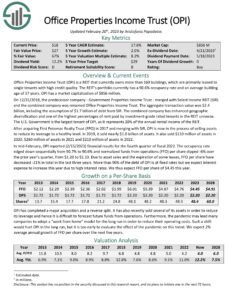
#2: Brandywine Realty Trust (BDN) – P/E ratio of 3.3
Brandywine Realty Trust is a REIT that owns, develops, leases and manages an urban town center and transit-oriented portfolio which includes 163 properties in Philadelphia, Austin and Washington, D.C. The REIT generates 75% of its operating income in Philadelphia, 19% of its operating income in Austin and the remaining 6% in Washington.
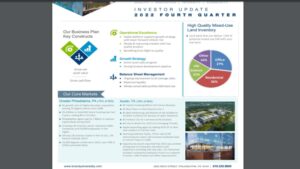
Source: Investor Presentation
As Brandywine Realty Trust generates the vast portion of its operating income in Philadelphia and Austin, it greatly benefits from the unique advantages of these two areas. According to official reports, Philadelphia has the highest growth rate of highly educated citizens since 2008 while Austin is the fastest-growing metropolitan area, the best place to start business and it has retrieved all the jobs lost due to the pandemic.
Just like most REITs, Brandywine Realty Trust is currently facing a strong headwind, namely the impact of fast-rising interest rates on the interest expense of the REIT. As a result, the stock has plunged to a 14-year low, trading at an all-time low price-to-FFO ratio of 3.3.
In addition, the stock is offering an all-time high dividend yield of 17.8%. The payout ratio is decent, at 66%, but Brandywine Realty Trust has a high leverage ratio (Net Debt to EBITDA) of 7.0. It also has a debt maturity in October-2024 and another one in June-2026. As a result, the dividend is likely to come under pressure in the event of an unforeseen downturn. The high debt load is the primary reason behind the freeze of the dividend for 17 consecutive quarters. Moreover, Brandywine Realty Trust is sensitive to recessions due to its weak balance sheet and the sensitivity of its tenants to recessions. Nevertheless, even if the REIT cuts its dividend, it will still be offering an above average yield. In addition, whenever inflation and interest rates revert to normal levels, the stock is likely to rebound strongly thanks to its depressed valuation.
Click here to download our most recent Sure Analysis report on Brandywine Realty Trust (BDN) (preview of page 1 of 3 shown below):
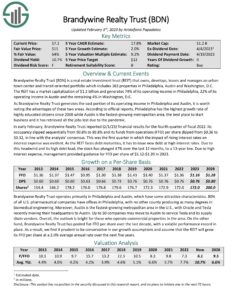
#3: SL Green Realty (SLG) – P/E ratio of 3.7
Founded in 1980, SL Green Realty is a REIT that is focused on acquiring and managing commercial properties in Manhattan. It is the largest office landlord in Manhattan, with 61 buildings that have a total surface area of 33 million square feet.
SL Green Realty has been severely hurt by the coronavirus crisis, which has resulted in a work-from-home trend. The pandemic has subsided since last year, but office space occupancy in New York remains near historic lows. Consequently, SL Green Realty is facing an unprecedented tenant-friendly environment, and hence it has been forced to offer material concessions to its tenants.
The persistence of the work-from-home trend has increased the uncertainty over the future growth prospects of SL Green Realty. However, we expect this trend to attenuate in the upcoming years, as the economic slowdown will probably increase the negotiation power of employers over their employees.
SL Green Realty is trading at an all-time low price-to-FFO ratio of 3.7 and is offering an all-time high dividend yield of 15.9%. The company has a healthy payout ratio of 59%, but its dividend is not safe due to its material debt load. Nevertheless, even after a dividend cut, the stock will offer an attractive yield. Overall, SL Green Realty has been severely hurt by a persistent work-from-home trend and high-interest rates, which have increased the interest expense of the REIT, but the stock seems deeply undervalued from a long-term perspective.
Click here to download our most recent Sure Analysis report on SL Green Realty (SLG) (preview of page 1 of 3 shown below):

#4: Douglas Emmett (DEI) – P/E ratio of 6.0
Douglas Emmett is a REIT that was founded in 1971. It is the largest office landlord in Los Angeles and Honolulu, with a 38% average market share of office space in its submarkets. The REIT generates 86% of its revenue from its office portfolio and 14% of its revenue from its multifamily portfolio. It has approximately 2,700 office leases in its portfolio and generates annual revenue of $1 billion.
The merits of being the largest office landlord in Los Angeles are obvious, as Los Angeles County is the third-largest city in the world, with GDP of $1 trillion, behind only Tokyo and New York. The dominant position of Douglas Emmett creates operational synergies. In addition, the REIT benefits from high barriers to entry, which reduce competition. Moreover, the proximity to premier housing attracts affluent tenants, who offer reliable cash flows to the company.
The markets of Douglas Emmett are characterized by high rent growth and relatively low volatility. Rents in the West Los Angeles submarkets of the REIT have grown 150% over the last 25 years, at a 3.7% average annual rate, the highest growth rate among all the U.S. gateway markets. Douglas Emmett certainly benefits from this trend, as its leases include 3%-5% annual rent hikes.
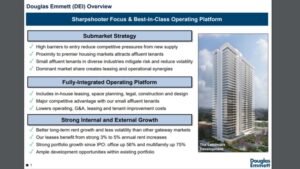
Source: Investor Presentation
Unfortunately, Douglas Emmett has not recovered from the coronavirus crisis yet, as the work-from-home trend has persisted longer than initially anticipated. In addition, the REIT is hurt by increased interest expense, which has resulted from rising interest rates.
However, we view these headwinds as temporary and believe that the stock has become exceptionally cheap. Douglas Emmett is trading at a 10-year low price-to-FFO ratio of 6.0, which is less than half of the 10-year average price-to-FFO ratio of 15.5 of the stock. Moreover, the stock is offering a nearly 10-year high dividend yield of 6.7%, with a solid payout ratio of 40%. To cut a long story short, whenever inflation subsides, Douglas Emmett is likely to offer excessive returns to the investors who can maintain a long-term perspective during the ongoing downturn.
Click here to download our most recent Sure Analysis report on Douglas Emmett (DEI) (preview of page 1 of 3 shown below):

#5: Annaly Capital Management (NLY) – P/E ratio of 6.1
Annaly Capital Management is a diversified capital manager that invests in and finances residential and commercial assets. The trust invests in various types of agency mortgage-backed securities, non-agency residential mortgage assets, and residential mortgage loans. The trust has elected to be taxed as a REIT.
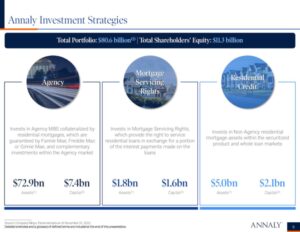
Source: Investor Presentation
Annaly borrows funds at short-term interest rates and invests in long-term securities. As a result, the company is extremely sensitive to the underlying interest rates and the yield curve, i.e., the difference between long-term and short-term interest rates.
Annaly is currently facing a perfect storm due to the aggressive interest rate hikes implemented by the Fed in an effort to restore inflation to normal levels. Due to the efforts of the Fed to cool the economy, short-term interest rates have risen above long-term interest rates. In other words, the market predicts that a recession will show up sooner or later.
As Annaly borrows funds at short-term interest rates and invests funds at long-term rates, it has become extremely hard for the company to make profitable new deals under the prevailing conditions. Nevertheless, the company is likely to remain profitable thanks to its existent investment portfolio. In addition, most of the damage has probably been done in reference to the stock price, as the Fed is not likely to raise interest rates much further.
Annaly is currently trading at a price-to-earnings ratio of only 6.1 and is offering an exceptionally high dividend yield of 13.7%. While its dividend is far from safe, it is likely to remain high even in the event of a dividend cut. Given the cheap valuation of the stock, its high dividend and the fact that the worse seems to be behind, Annaly is likely to highly reward patient investors in the upcoming years.
Click here to download our most recent Sure Analysis report on Annaly Capital Management (NLY)(preview of page 1 of 3 shown below):

#6: Chimera Investment Corporation (CIM) – P/E ratio of 6.1
Chimera Investment Corporation is a REIT that is a specialty finance company. It invests through its subsidiaries in a diversified portfolio of mortgage assets, including residential mortgage loans, non-agency residential mortgage assets, and other real estate related securities.

Source: Investor Presentation
The profit of Chimera is determined by the difference between the yield of its investments, which depends on long-term interest rates, and the interest rate paid for its borrowed funds, which depends on short-term interest rates. As a result, the company is extremely sensitive to the underlying interest rates and the yield curve, i.e., the difference between long-term and short-term interest rates.
Just like Annaly, Chimera has been severely hurt by the aggressive interest rate hikes implemented by the Fed since early last year. Due to the efforts of the Fed to cool the economy, short-term interest rates have risen above long-term interest rates. In other words, the market expects a recession to show up in the near future.
The negative slope of the yield curve has made it extremely hard for Chimera to make a profit in new transactions. Nevertheless, the company is likely to remain profitable thanks to its existent investment portfolio. In addition, most of the damage has probably been done, as the Fed is not likely to raise interest rates much further.
Chimera is trading at a remarkably low P/E ratio of 6.1 and is offering a 10-year high dividend yield of 16.9%. Given the extreme payout ratio of 102% and the vulnerability of Chimera to the current investing environment, its dividend is far from safe. Nevertheless, even after a dividend cut, the stock will still be offering an above average yield. Thanks to its cheap valuation, the stock is attractive from a long-term perspective, particularly given that the worse seems to be behind the company.
Click here to download our most recent Sure Analysis report on Chimera Investment Corporation (CIM) (preview of page 1 of 3 shown below):

#7: Walgreens Boots Alliance (WBA) – P/E ratio of 7.3
Walgreens Boots Alliance is the largest retail pharmacy in both the U.S. and Europe. Through its flagship Walgreens business and other business ventures, the company is present in more than 9 countries, with more than 13,000 stores in the U.S., Europe and Latin America.
Walgreens has grown its earnings per share by 7.6% per year on average over the last decade but it has stalled over the last five years, mostly due to heating competition, which has taken its toll on the margins of the company. In addition, the profit margins in the pharmaceutical business have become an object under scrutiny in recent years. As a result, investors should not expect meaningful margin expansion for the foreseeable future.
Walgreens is also facing another headwind, namely the fading positive effect of the pandemic. In the first quarter of 2023, the company executed only 8.4 million vaccinations, which were much lower than the 11.8 million vaccinations in the second quarter of 2022. As a result, total revenues decreased 1.5% and adjusted earnings per share plunged 30% over the prior year’s quarter.
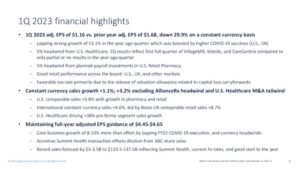
Source: Investor Presentation
It is also remarkable that Walgreens failed to receive an attractive bid for its Boots business. Due to its lackluster growth prospects, Walgreens has been punished to the extreme by the market. The stock is currently trading at a 10-year low P/E ratio of 7.3, which is about half of its 10-year average P/E ratio.
Moreover, Walgreens has raised its dividend for 47 consecutive years and is currently offering a nearly 10-year high dividend yield of 5.9%. The company has a solid payout ratio of 42%, a healthy balance sheet and it has proved resilient to recessions thanks to the essential nature of its business. Therefore, investors can lock in the exceptionally high dividend yield of the stock and rest assured that the dividend is safe. Given also the extremely cheap valuation of Walgreens, we view the stock as highly attractive for patient investors.
Click here to download our most recent Sure Analysis report on Walgreens Boots Alliance (WBA) (preview of page 1 of 3 shown below):
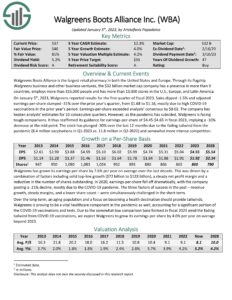
#8: Cousins Properties (CUZ) – P/E ratio of 7.4
Cousins Properties is a self-managed REIT that was founded in 1958 and acquires, develops and leases office buildings in high-growth Sun Belt markets.

Source: Investor Presentation
The trust generates 36% of its operating income in Atlanta and 31% of its operating income in Austin. Sun Belt markets are attractive thanks to their superior economic growth compared to most other regions of the U.S.
Cousins Properties has been hurt by the coronavirus crisis, which has led many companies to adopt a work-from-home model. This downturn has caught the REIT with a high debt load and hence the trust has been forced to sell some properties in order to endure the crisis. Its total rentable square feet have decreased in each of the last three years. Moreover, the trust has a high leverage ratio (Net Debt to EBITDA) of 4.9. Nevertheless, we believe that the worse is behind the company.
Apart from the work-from-home trend, Cousins Properties is now facing another strong headwind, namely increasing interest expense due to fast-rising interest rates. Management recently provided guidance for an approximate 5% decrease in FFO per unit in 2023, primarily due to higher interest expense.
While Cousins Properties is facing adverse business conditions right now, investors should note that the stock has become remarkably cheap. The REIT is trading at a 10-year low price-to-FFO ratio of 7.4, which is far lower than the 10-year average price-to-FFO ratio of 12.7 of the stock. In addition, the stock is offering a 10-year high dividend yield of 6.7%, with a healthy payout ratio of 49%. Due to the weak balance sheet of the company, the dividend is not entirely safe. However, whenever inflation and interest rates revert to normal levels, Cousins Properties is likely to highly reward investors off its current depressed stock price.
Click here to download our most recent Sure Analysis report on Cousins Properties (CUZ) (preview of page 1 of 3 shown below):

#9: AT&T (T) – P/E ratio of 7.6
AT&T is a diversified, global leader in telecommunications, serving more than 100 million customers. Almost a year ago, AT&T completed the spin-off of WarnerMedia.
AT&T is a colossal business, which generates approximately $120 billion of annual revenues. However, the company has grown its earnings per share by only 0.3% per year on average over the last decade. As a result, the stock has dramatically underperformed the broad market over the last decade; it has shed 33% whereas the S&P 500 has rallied 153%.
The poor performance of AT&T has resulted primarily from some markedly poor investing decisions. AT&T acquired DirecTV for $65 billion in 2015, close to the peak of the business of the acquired company. After having lost about 10 million subscribers, AT&T spun off DirecTV, with an implied enterprise value of only $16.25 billion. A similar situation was evidenced with Time Warner, which AT&T acquired in 2018 but spun off last year. In both situations, AT&T bought high and sold low, thus reducing shareholder value.
Due to its poor performance record, AT&T is now trading at a nearly 10-year low P/E ratio of 7.6. The cheap valuation has resulted in an above average dividend yield of 6.0%. We believe that AT&T has become exceptionally attractive from a long-term point of view.
After a series of failed investments, AT&T is now focusing on its core business. As a result, the company has already begun to improve its performance.

Source: Investor Presentation
Whenever the market appreciates the virtues of the lean business model of AT&T, it is likely to reward the stock with a higher P/E ratio.
Click here to download our most recent Sure Analysis report on AT&T (T) (preview of page 1 of 3 shown below):
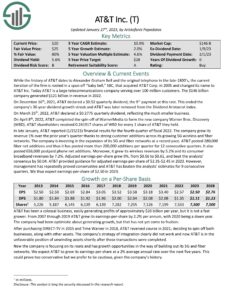
#10: American Assets Trust (AAT) – P/E ratio of 7.6
American Assets Trust is a REIT that was formed in 2011 as a successor of American Assets, a privately held company founded in 1967. American Assets Trust is headquartered in San Diego, California, and has great experience in acquiring, improving and developing office, retail and residential properties throughout the U.S., primarily in Southern California, Northern California, Oregon, Washington and Hawaii.
Its office portfolio and its retail portfolio comprise of approximately 4.0 million and 3.1 million square feet, respectively.

Source: Investor Presentation
American Assets Trust also owns more than 2,000 multifamily units.
The growth strategy of American Assets Trust involves the acquisition of properties in submarkets with favorable supply and demand characteristics, including high barriers to entry. In addition, the REIT redevelops many of its newly-acquired properties in order to enhance their value. It also has a capital recycling strategy, which involves selling properties whose returns seem to have been maximized and buying high-return properties.
Thanks to these growth drivers, American Assets Trust has grown its FFO per unit every single year over the last decade, except for 2020 due to the pandemic. The REIT has grown its FFO per unit at a 4.4% average annual rate during this period. Moreover, it proved fairly resilient to the pandemic and has already recovered from that crisis.
American Assets Trust appears resilient to high inflation thanks to its ability to raise rental rates significantly every year. On the other hand, it has decelerated lately, as it has begun to face tough comparisons over exceptionally strong results in the prior year’s period. As a result, the stock has been punished by the market.
American Assets Trust is currently trading at a 10-year low price-to-FFO ratio of 7.6, which is less than half of the 5-year average price-to-FFO ratio of 17.1 of the stock. In addition, the stock is offering a 10-year high dividend yield of 7.7%. Given the healthy payout ratio of 59% and the reliable growth trajectory of the REIT, the dividend is safe. The only concern is the material debt load of the REIT, which has an interest coverage ratio of only 2.0.
On the bright side, American Assets Trust has received investment grade ratings from the major rating agencies. Given the promising growth potential of the REIT, we do not expect it to face any problems servicing its debt. Therefore, we expect American Assets Trust to offer excessive returns to investors whenever the economy recovers from its latest slowdown.
Click here to download our most recent Sure Analysis report on American Assets Trust (AAT) (preview of page 1 of 3 shown below):
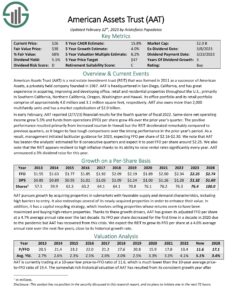
#11: Kinder Morgan (KMI) – P/E ratio of 7.9
Kinder Morgan is among the largest energy companies in the U.S. It is engaged in storage and transportation of oil and gas and other products. It owns an interest in or operates approximately 83,000 miles of pipelines and 140 terminals.
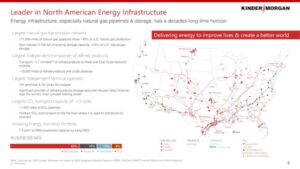
Source: Investor Presentation
Kinder Morgan has a robust business model, as it generates nearly all its cash flows from fee-based contracts and minimum-volume contracts. The company generates nearly 70% of its operating income from minimum-volume contracts. In other words, its customers pay a minimum amount to Kinder Morgan every year even if they transport much lower volumes than normal.
Moreover, Kinder Morgan is resilient to the secular shift from fossil fuels to clean energy sources. While oil companies are vulnerable to this shift, which has greatly accelerated in the last three years, Kinder Morgan is focused primarily on natural gas, which is a much cleaner fuel than oil products. As a result, all the environmental policies that aim to reduce oil consumption do not aim to reduce natural gas consumption and hence Kinder Morgan is hardly affected by environmental policies.
The resilience of Kinder Morgan was also proved throughout the coronavirus crisis. Most oil companies incurred excessive losses in 2020 due to the collapse of the prices of oil and gas in that year. On the contrary, Kinder Morgan incurred just an 8% decrease in its distributable cash flow (DCF) per unit in that year. An 8% decrease in one of the fiercest downturns of the energy sector is certainly admirable. Moreover, the company recovered strongly in 2021, with a record distributable cash flow per unit in that year.
Kinder Morgan is currently trading at an attractive price-to-DCF ratio of 7.9. The company has raised its dividend for 5 consecutive years and it is offering an above average dividend yield of 6.6%. Thanks to its solid payout ratio of 52% and its defensive business model, Kinder Morgan is likely to keep raising its dividend for many more years. Therefore, investors should take advantage of its exceptionally high yield and cheap valuation.
Click here to download our most recent Sure Analysis report on Kinder Morgan (KMI) (preview of page 1 of 3 shown below):

#12: Verizon (VZ) – P/E ratio of 8.0
Verizon, which was created by the merger of Bell Atlantic with GTE in 2000, is one of the largest wireless carriers in the country. Wireless generates three-quarters of the total revenues of the company while broadband and cable services account for about a quarter of sales. The network of Verizon covers approximately 300 million people and 98% of the U.S.
Verizon enjoys a key competitive advantage, namely its reputation as the best wireless carrier in the U.S. This is clearly reflected in the wireless net additions of the company and its exceptionally low churn rate. This reliable service allows Verizon to maintain its customer base and move some customers to higher-priced plans.
Verizon exhibits lackluster business momentum right now. Last year, the company posted essentially flat sales and saw its earnings per share dip 6% due to high operating expenses as well as high interest expense. Verizon has provided guidance for earnings per share of $4.55-$4.85 in 2023, implying a further 7% decrease.

Source: Investor Presentation
Nevertheless, it is important to note that the stock has become exceptionally cheap. To be sure, Verizon is currently trading at a nearly 10-year low P/E ratio of 8.0 and is offering a 10-year high dividend yield of 6.9%. Thanks to the solid payout ratio of 56%, the strong business position of the company and its resilience to recessions, its dividend should be considered safe. It is also worth noting that Verizon has grown its dividend for 18 consecutive years. Overall, whenever Verizon returns to growth mode, it is likely to offer excessive returns to those who purchase the stock around its current stock price.
Click here to download our most recent Sure Analysis report on Verizon (VZ) (preview of page 1 of 3 shown below):
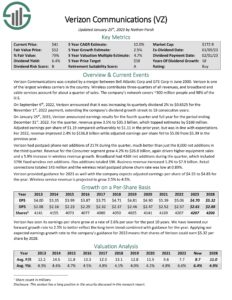
#13: Altria (MO) – P/E ratio of 8.8
Altria is a consumer staples giant, with a history of 175 years. The company is the producer of the top-selling cigarette brand in the world, namely Marlboro, as well as some non-smokeable products. The tobacco giant has maintained a market share of about 40%-43% for several years in a row.

Source: Investor Presentation
Altria also has large stakes in global beer giant Anheuser Busch InBev (BUD) and Cronos Group (CRON), a cannabis company.
Altria has a rock-solid business model in place. Thanks to the inelastic demand for its products, the company has been raising its prices year after year. As a result, it has more than offset the effect of the steadily declining consumption per capita of cigarettes on its earnings. Thanks to its strong pricing power, Altria has grown its earnings per share every single year over the last decade, at an 8.8% average annual rate. The consistent growth record of Altria is a testament to the strength of its business model.
On the other hand, Altria has been caught off-guard in the ongoing transition of consumers towards alternative tobacco products, such as vaping products. About five years ago, Altria acquired a 35% stake in Juul, a leader in vaping products, for $12.8 billion but that investment proved disastrous. After the acquisition, Juul incurred several hits due to restrictions from regulatory authorities. The company is also facing excessive potential fines from regulators in the future. Consequently, Altria recently divested its stake in Juul and thus its whole investment in the company evaporated.
Due to its failed investment and its weak position in alternative tobacco products, Altria is currently trading at a nearly 10-year low price-to-earnings ratio of 8.8 and is offering a nearly 10-year high dividend yield of 8.6%, with a 10-year low payout ratio of 75%. The stock has become extremely cheap. It is also remarkable that Altria continues growing its earnings per share to new all-time highs year after year. The company is on track to grow its bottom line by about 4% this year. Whenever the market shift its focus on the rock-solid business model of Altria, the stock is likely to offer excessive returns to its shareholders off its current depressed price.
Click here to download our most recent Sure Analysis report on Altria (MO) (preview of page 1 of 3 shown below):
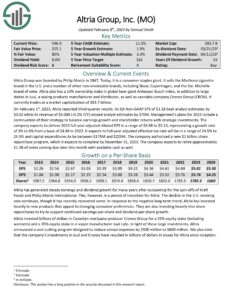
#14: V.F. Corporation (VFC) – P/E ratio of 9.7
V.F. Corporation has a history of more than a century and is one of the largest apparel, footwear and accessories companies in the world. Its brands include The North Face, Vans, Timberland and Dickies.
V.F. Corporation is currently facing a severe downturn due to the multiple impact of nearly 40-year high inflation on the stock. Excessive inflation has pronouncedly increased the cost of raw materials, the freight costs and the labor costs of V.F. Corporation. Consequently, it exerts great pressure on the operating margins of the retailer.
In addition, due to the impact of inflation on the real purchasing power of consumers, the latter have become conservative in their spending. As a result, the inventories of V.F. Corporation have nearly doubled over the prior year. This has led the company to offer deep discounts in an effort to reduce its inventory to healthier levels and thus the operating margins of V.F. Corporation are under great pressure.

Source: Investor Presentation
Due to the impact of sky-high inflation on its business, V.F. Corporation recently cut its dividend by 41%, after 50 consecutive years of dividend growth. Nevertheless, the stock is still offering a nearly 10-year high dividend yield of 5.9%. It also has a solid payout ratio of 57% and a rock-solid balance sheet and hence its new dividend should be considered safe.
Moreover, V.F. Corporation is trading at a fresh 10-year low, at a nearly 10-year low P/E ratio of 9.7. Furthermore, the Fed is determined to restore inflation to its target level of 2%. Thanks to the aggressive stance of the Fed, inflation has subsided every month since it peaked last summer. When inflation reverts to normal levels, V.F. Corporation is likely to enjoy a strong rebound in its business and thus it will probably highly reward patient investors.
Click here to download our most recent Sure Analysis report on V.F. Corporation (VFC) (preview of page 1 of 3 shown below):
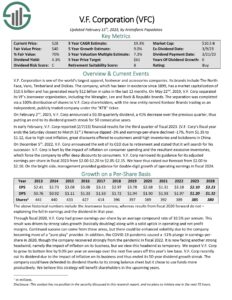
#15: Lazard (LAZ) – P/E ratio of 10.0
Lazard is a financial advisory company, with a history of 175 years and operations in 43 cities worldwide.

Source: Investor Presentation
The company has two business divisions, namely Financial Advisory and Asset Management. The former includes investor analytics, debt issuance, mergers and acquisitions, debt restructuring, chapter 11 and capital raises while the latter is focused primarily on institutional clients.
Lazard has a great reputation in its business, as it is considered one of the most reliable companies in the financial world. When a company or a country faces financial problems, it often consults Lazard in order to evaluate its options and restructure its debt in the most efficient way. The customers of Lazard pay appreciable amounts to the company for its consulting services but they earn even more thanks to the expertise of Lazard.
Lazard is likely to incur a decline in its earnings this year due to the global economic slowdown caused by the interest rate hikes implemented by most central banks, the resultant decrease in assets under management and the reduced transaction activity of the customers of the company.
With that said, the stock has become exceptionally cheap. Lazard is currently trading at a nearly 10-year low P/E ratio of 10.0 and is offering a 10-year high dividend yield of 6.1%. Lazard has a decent payout ratio of 61% and a strong balance sheet, with a BBB+ credit rating from S&P and Fitch. Moreover, the company does not have any debt maturities until 2025 while management has repeatedly affirmed its commitment for a growing dividend. Given also its reliable business model, Lazard is not likely to cut its 6.1% dividend. Overall, the stock is likely to offer excessive returns to investors whenever the global economy shows signs of recovery from its latest slowdown.
Click here to download our most recent Sure Analysis report on Lazard (LAZ) (preview of page 1 of 3 shown below):

#16: Easterly Government Properties (DEA) – P/E ratio of 11.1
Easterly Government Properties is an internally managed REIT with a focus on acquisition, development and management of properties which are leased to U.S. Government agencies. Most of the properties of the REIT are leased to U.S. government agencies, such as the FBI, IRS, and DEA.
Easterly Government Properties has found a lucrative niche in the real estate business and has been working to become a brand name in its field of U.S. Government leasing. Its operations are viewed as safe investments, as the U.S. government is the most reliable tenant a landlord can find. Within the U.S. Government, Easterly Government Properties leases to predominantly agencies which are considered as essential services. This helps explain how the trust has been able to achieve an outstanding 100% occupancy rate. Moreover, the REIT has well-laddered lease maturities.

Source: Investor Presentation
Unfortunately, Easterly Government Properties has a somewhat lackluster performance record, as it has failed to grow its FFO per unit meaningfully over the last five years. On the other hand, the stock is markedly cheaply valued. It is trading at an 8-year low price-to-FFO ratio of 11.1 and is offering an 8-year high dividend yield of 8.3%. The payout ratio is high, at 93%, but the dividend may be sustained thanks to the defensive business model of the REIT. We expect the stock to rebound strongly whenever inflation reverts to its long-term range.
Click here to download our most recent Sure Analysis report on Easterly Government Properties (DEA) (preview of page 1 of 3 shown below):
#17: 3M Company (MMM) – P/E ratio of 11.5
3M Company sells more than 60,000 products, which are used every day in homes, hospitals, office buildings and schools around the world. The industrial manufacturer has presence in more than 200 countries.
3M has a key competitive advantage, namely its exemplary department of Research & Development (R&D). The company has consistently spent 5%-6% of its total revenues (nearly $2 billion per year) on R&D in order to create new products and thus meet changing consumer needs. This strategy has certainly born fruit, as it has resulted in a portfolio of more than 100,000 patents. Thanks to its focus on innovation, 3M generates nearly one-third of its revenues from products that did not exist five years ago.
3M is currently facing a headwind due to high cost inflation. However, thanks to its dominant business position, the company has strong pricing power. As a result, it has been able to pass its increased costs to its customers via material price hikes. This is clearly reflected in the business performance of 3M, as the company posted nearly all-time high earnings per share in 2022.
3M is a Dividend King, with one of the longest dividend growth streaks in the investing universe. The company has raised its dividend for 64 consecutive years and is currently offering a 10-year high dividend yield of 5.9%. The stock is also trading at a 10-year low P/E ratio of 11.5.
The exceptionally cheap valuation of 3M has resulted from a strong headwind, namely numerous pending lawsuits. There are nearly 300,000 claims that its earplugs, which were used by U.S. combat troops and were manufactured by Aearo Technologies, a subsidiary of 3M, were defective. The subsidiary of 3M filed for bankruptcy but a U.S. judge ruled that this bankruptcy would not prevent lawsuits from burdening 3M. As a result, no-one can predict the final amount of liabilities that 3M will have to pay to its plaintiffs.
Nevertheless, thanks to its rock-solid balance sheet, 3M is likely to prove capable of enduring this headwind and emerging stronger after this crisis is over. 3M has an interest coverage ratio of 12.1 and net debt to market cap of only 32%.

Source: Investor Presentation
Given also its healthy payout ratio of 58% and its reliable business performance, 3M is likely to continue raising its dividend for many more years.
Click here to download our most recent Sure Analysis report on 3M Company (MMM) (preview of page 1 of 3 shown below):
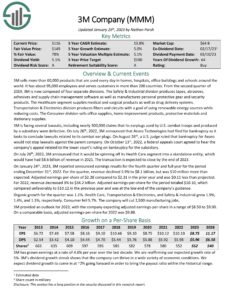
#18: LTC Properties (LTC) – P/E ratio of 12.2
LTC Properties is a REIT that invests in senior housing and skilled nursing properties. Its portfolio consists of approximately 50% senior housing and 50% skilled nursing properties. The REIT owns 216 investments in 29 states with 32 operating partners.
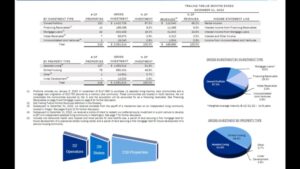
Source: Investor Presentation
LTC Properties has been hurt by the bankruptcy of Senior Care Centers, which is the largest skilled nursing operator in Texas. Senior Care filed for Chapter 11 bankruptcy in December-2018. Until 2018, it was generating 9.7% of the annual revenues of LTC Properties and was the fifth largest customer of the trust.
On the bright side, LTC Properties has most of its assets in states with the highest projected increases in the 80+ population cohort over the next decade. Moreover, LTC Properties is currently recovering from the coronavirus crisis.
LTC Properties is currently offering a 10-year high dividend yield of 6.9%. The REIT has raised its dividend at a 2.3% average annual rate over the last decade. However, it has frozen its dividend in the last six years due to the absence of underlying growth. Consequently, it is prudent not to expect dividend growth anytime soon. The payout ratio is 84% and the balance sheet is leveraged, with a debt to adjusted EBITDA ratio of 5.0 and an interest coverage ratio of 3.5. As a result, the dividend may come under pressure if LTC Properties faces a strong headwind, such as a recession. Fortunately, the REIT does not have material debt maturities for the next five years.
Moreover, LTC Properties is trading at a 10-year low price-to-FFO ratio of 12.2, which is much lower than the 10-year average price-to-FFO ratio of 15.1 of the stock. The exceptionally cheap valuation has resulted primarily from the effect of high interest rates on the interest expense of the REIT. Whenever interest rates normalize, the stock is likely to enjoy a strong rally off its depressed price.
Click here to download our most recent Sure Analysis report on LTC Properties (LTC)(preview of page 1 of 3 shown below):
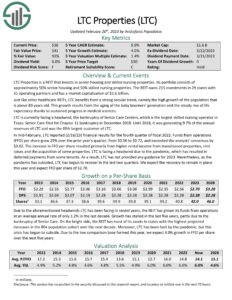
#19: Philip Morris (PM) – P/E ratio of 14.8
Philip Morris was formed when its parent company Altria spun off its international operations. Philip Morris sells cigarettes under the Marlboro brand and others brands in international markets.
Philip Morris has one of the most valuable cigarette brands in the world, Marlboro, and is a leader in the reduced-risk product category with iQOS.

Source: Investor Presentation
Thanks to its strong business position, it is a low-risk business. The only material risk comes from potential restrictions from regulatory authorities but Philip Morris is safer than many other tobacco companies in this regard thanks to its broad geographic diversification.
Philip Morris has grown its dividend for 15 consecutive years and is currently offering a nearly 10-year high dividend yield of 5.6%. Its payout ratio is too high, at 83%, but the company is likely to be able to defend its dividend now that its past investments have begun to bear fruit and capital requirements have decreased sharply. Nevertheless, it is prudent for investors to be prepared for modest dividend growth going forward.
On the other hand, thanks to the strong business momentum of its alternative tobacco products, Philip Morris expects to grow its currency-neutral earnings per share by about 6% this year, from $5.81 to an all-time high of $6.09-$6.21. Moreover, the stock is trading at a nearly 10-year low P/E ratio of 14.8. This earnings multiple is exceptionally low for this stock, which has always enjoyed a premium valuation thanks to its strong business model and its generous dividends. The earnings of the company have been hurt by a strong dollar but we expect the market to reward the stock with a higher P/E ratio whenever the dollar depreciates vs. the other major currencies.
Click here to download our most recent Sure Analysis report on Philip Morris (PM) (preview of page 1 of 3 shown below):

#20: Realty Income (O) – P/E ratio of 15.0
Realty Income is a retail REIT that is well known for its outstanding dividend growth history. The trust owns more than 4,000 retail properties.
Many investors avoid retail REITs due to the secular shift of consumers from brick-and-mortar shopping to online purchases. However, Realty Income continues to thrive in the current business landscape. The REIT owns retail properties that are not part of a wider retail development, such as a mall, but are standalone properties. As a result, the properties of Realty Income can attract several types of tenants and hence the company is essentially immune to the secular decline of brick-and-mortar retailers.
The key competitive advantage of Realty Income is its exemplary management, which has great expertise in identifying high-return properties. Thanks to its solid growth strategy, Realty Income has grown its FFO per unit every single year over the last decade, at a 5.5% average annual rate. It has achieved such a consistent growth record thanks to the acquisition of high-return properties and predictable rent hikes year after year.
Moreover, Realty Income has proved extremely resilient to recessions. In the Great Recession, while other REITs cut their dividends, Realty Income continued growing its dividend. The REIT has raised its dividend for 100 consecutive quarters.
Realty Income has grown its dividend at a 4.4% average annual rate since 1994, with 119 dividend hikes since then.

Source: Investor Presentation
The REIT is currently offering a nearly 10-year high dividend yield of 5.0% and is trading at a nearly 10-year low price-to-earnings ratio of 15.0. The exceptionally cheap valuation of the stock has resulted primarily from the impact of inflation on the present value of future cash flows and the effect of high interest rates on interest expense. Whenever inflation and interest rates revert to normal levels, Realty Income will almost certainly offer excessive returns.
Click here to download our most recent Sure Analysis report on Realty Income (O) (preview of page 1 of 3 shown below):

Final Thoughts
All the above stocks are trading at remarkably cheap valuation levels due to some business headwinds. Some of them have been hurt by high inflation or the latest economic slowdown whereas others are facing their own specific issues. Most of the above stocks are likely to highly reward investors off their current depressed levels. Moreover, all the above stocks are offering dividend yields above 5%. Thus, they make it much easier for investors to wait patiently for the business headwinds to subside.
If you are interested in finding more high-quality dividend growth stocks suitable for long-term investment, the following Sure Dividend databases will be useful:
The major domestic stock market indices are another solid resource for finding investment ideas. Sure Dividend compiles the following stock market databases and updates them monthly:
Thanks for reading this article. Please send any feedback, corrections, or questions to [email protected].
















